
It was thus an anxious and tense Prime Minister who departed Sydney by ship on 5 April 1944 bound for the United States. Before leaving, Curtin was keen to limit expectations. 'There can be no final answer to nine-tenths of the [world's] problems', he told colleagues and reporters. 'I would be a very foolish man if I believed that the representative of the Australian nation is going to sit and lay down the rule for the representatives of other mighty nations.' 32 The long journey then lived up to many of Curtin's bleak expectations. The two-week voyage across the Pacific was marred by his wife's adverse reaction to a smallpox jab and his own constant fears of a Japanese torpedo attack; the four-day train trip across the United States was beset by cold and unseasonable snow flurries.
Yet, on close inspection, some of Curtin's more substantive forebodings were clearly overblown, not least because of the increasingly complex nature of the two country's decision-making structures. As discussed earlier, neither government was a monolith. Both had its internal divisions. And in the months before Curtin's trip, tension had flared largely because diplomacy had been conducted by subordinates and not by the men at the very top.
Indeed, as attention shifted to the post-war world, U.S.-Australian relations were increasingly in the hands of Dr. Evatt and Cordell Hull, two diplomats who were frequently undiplomatic and whose abrasive styles had clearly fuelled the current controversy. It was these two men who had engaged in a bout of caustic correspondence after the ANZAC agreement, accusing each other of adopting an 'officious tone', of misusing minutes of meetings and even of abandoning fundamental allied war aims. 33
On the American side as well, it was Secretary of State Hull who fanned the flames in other parts of the national security bureaucracy, by circulating memoranda that placed the worst possible emphasis on Australia's ambitions. Hull's motivation was partly personal: like many American officials he disliked and distrusted Evatt. But Hull also had an ideological axe to grind: utterly obsessed with free trade, he already had little time for a country like Australia that he thought remained firmly wedded to the protectionist system of imperial preference. 34 In addition, Hull was currently in the process of seeking congressional support for American membership of a collective security arrangement, and he feared that Evatt's proposal in the ANZAC agreement for an early regional conference to discuss Pacific issues might easily derail this delicate domestic task. 35
Thus if Evatt was widely disliked in Washington, then Hull was about the worst U.S. official to be left in charge of America's delicate relations with Canberra. Yet crucially, neither man was particularly trusted by their boss. Curtin was increasingly suspicious of Evatt's political ambitions, especially after rumours had abounded that Evatt was manoeuvring to replace him in the wake of the 1943 election. And Curtin consciously decided not to take anyone from External Affairs on his trip to Washington and London, despite Evatt's constant pleas. 36 Roosevelt, for his part, had long bypassed Cordell Hull. Distrusting the 'striped pants' boys in the State Department, Roosevelt generally acted as his own Secretary of State, keeping Hull out of the most important policy areas and even refusing to let him see the minutes of his recent conference with Stalin and Churchill at Tehran. 37
Seen in this light, a meeting between Curtin and Roosevelt offered a perfect opportunity to repair relations. Both men could heap the blame for recent troubles on their foreign policy lieutenants. More importantly, they could also discover that, beneath Evatt's and Hull's recent diplomatic spat, both governments were not always too far apart on many of key issues. In fact, much of the recent tension had stemmed from a lack of consultation. This had created a feeling in both capitals that either side was being ignored by an arrogant ally. It had also created a tendency inside both governments to magnify their policy differences. But when the two leaders actually sat down together, these misunderstandings could easily be swept aside, especially as both men shared similar ideas on a number of issues that would affect their post-war relations.
For a start, Curtin and Roosevelt were always ideologically quite close. As well as their similar domestic agendas, underlined by FDR's economic bill of rights, which he unveiled with great fanfare in January 1944, the two men were fervent internationalists who agreed that a new United Nations organization should replace the League of Nations, and that it should form the cornerstone of post-war global security. Roosevelt, to be sure, had moved cautiously on the subject, acutely aware how Woodrow Wilson's political miscalculations in 1918-1919 had ended with the U.S. Senate refusing to sanction American involvement in the League. But by 1944 Roosevelt had become the main driving force behind the UN, sketching out the organizational framework that would underpin the new organization, selling his vision to international allies and moving slowly to construct powerful domestic support. 38
Curtin was one ally who would be easy to convince. Although critical about the structure and effectiveness of the League of Nations, Curtin was in no doubt that post-war peace would depend on a global collective security system. Of course, as the leader of a smaller power, Curtin's focus was somewhat different from the American President's. In mapping out a replacement for the failed League of Nations, Roosevelt always emphasized the role of great powers. He wanted the big four allies - the United States, Soviet Union, Britain and China - to dominate, acting as the world's 'four policemen' to prevent future breaches of the peace. 39 Curtin, for his part, agreed that the earlier League of Nations system had given too much of a say to the smaller powers. But Curtin was also keen to ensure that 'the pendulum' did not 'swing too far in the other direction.' To this end, he championed an Assembly of Nations, where the smaller powers like Australia could make their voice heard and have an input in policy. 40
This different perspective between a big and a small power pointed to one possible source of disagreement. But it was not the only potential friction point. Far more troubling was the complex matter of how this new global security regime would interact with regional arrangements. And here, Curtin held some firm views. 41
At one level, Curtin was an increasingly vocal champion of the British Empire. Convinced that the war would create a new imperial arrangement with the Dominions having a greater say, hopefully through the creation of an Empire Council, Curtin now saw the British Empire as a force for good in the world and a vital component of Australia's defences in the South Pacific. 42 At a second level, Curtin also stressed 'the supreme importance' of buttressing both the British Empire and the new collective security organization with a series of 'regional arrangements and plans.' 43 By this he basically meant the controversial ANZAC agreement, which wasn't merely a veiled attack on America's unwillingness to consult Australia on key issues; it was also a way of containing excessive American influence in the Southwest Pacific. 44 Perhaps the ANZAC pact might even be used to further Australia's territorial aspirations. Evatt was certainly inclined in this direction, and had recently discussed the possibility of securing Australian sovereignty over a string of islands, including Fiji, the Solomons, Java and the Dutch East Indies. 45
This suggestion of an Australian sub-empire in the South Pacific appalled Cordell Hull and the State Department, for they were opposed to 'closed' spheres of influence in general and what they considered to be Australia's grasping land grab in particular. But what was Roosevelt's view? The President, of course, was a well-known critic of the British Empire. Whereas Curtin now talked about strengthening imperial machinery, Roosevelt often discussed ways of dismantling an Empire he saw as outdated and an obstacle to progress. Moreover, when it came to disposing of territory in Asia, Roosevelt was generally convinced that no allied power should acquire complete control. In his opinion, areas not yet ready for self-government should be held in trusteeship for a limited time by one or more of the world's new 'policemen'. 46
Yet, on close inspection, Roosevelt was surprisingly flexible on these two issues. He was always able to hold complex, even contradictory, views in his head. And although his attitude towards empire always seemed so strident and clear, Roosevelt generally left room for a degree of ambiguity, which perhaps suggested that he and Curtin would find areas of agreement when they actually met.
The British Empire's role in world security was one of these areas of possible agreement. Essentially, Roosevelt saw Britain's relationship with the Dominions as an important way of providing post-war stability in certain regions. The British, after all, were one of Roosevelt's 'four policemen'. And, as Christopher Thorne pointed out, Roosevelt and his leading advisers tended to act as if the British Commonwealth 'would constitute a post-war asset for the United States' in its bid to create a stable international order. Roosevelt was therefore not averse to Curtin's basic conception of the Commonwealth's continued importance (although he certainly wouldn't have endorsed some of Curtin's grandiose talk about the Empire being a model for international democracy!). 47
At the same time, Roosevelt was also broadly sympathetic to some of Australia's territorial ambitions. On numerous occasions, Roosevelt hinted that America's own Pacific claims would be north of the equator, that its position in the south was basically soft and that he was sure 'the Americans and the Australians could work together on a liberal policy on these matters.' 48 Although a champion of trusteeship rather than direct control, Roosevelt even contemplated offering Australia the chance to purchase West Timor from the Dutch. 49 As Anthony Eden, the British Foreign Secretary, commented after discussing these issues in Washington, Roosevelt was far less hostile to the imperial aspirations of new regional powers like Australia than he was towards the old style colonial rule of European powers like the British in India and the French in Indochina. 50
In fact, on many post-war questions, the two men's views overlapped to a surprising degree. Both saw the need for continued allied cooperation to 'police' trouble spots. 51 Both talked about the alliance as a 'family' unit, which must be held together in the future. 52 And, crucially, both agreed about the best way of turning this wartime alliance into a durable post-war arrangement. Indeed, neither Curtin nor Roosevelt favoured a detailed, rigid framework. They wanted to begin, instead, with what Curtin described as 'a loose sort of show', working through existing structures and using these to slowly construct a sturdy new system of global security. 53
In sum, then, a number of factors pointed in the direction of a constructive summit. In recent months, to be sure, the Australian-American official discourse had tended to emphasize major differences rather than shared visions. But with Curtin and Roosevelt finally poised to meet, the two leaders had an obvious chance to rectify this and place the alliance on a far sounder footing.
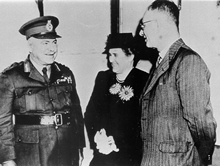 John & Elsie Curtin with General Blamey on board "Lurline" before leaving Sydney for USA, 1944. Records of the Curtin Family. JCPML00376/129.
John & Elsie Curtin with General Blamey on board "Lurline" before leaving Sydney for USA, 1944. Records of the Curtin Family. JCPML00376/129.
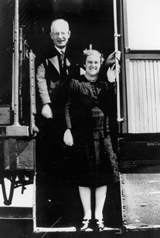 Curtin and Elsie on board US train, 1944. Records of Frederick McLaughlin. JCPML00018/5.
Curtin and Elsie on board US train, 1944. Records of Frederick McLaughlin. JCPML00018/5.
 Elsie Curtin alighting from US train helped by Frederick McLaughlin and US aide, Curtin behind., 1944. Records of Frederick McLaughlin. JCPML00018/1.
Elsie Curtin alighting from US train helped by Frederick McLaughlin and US aide, Curtin behind., 1944. Records of Frederick McLaughlin. JCPML00018/1.
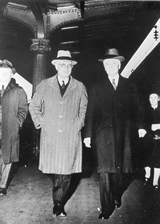 P.M. John Curtin with U.S.A. Secretary of State, Cordell Hull. Mrs Curtin in R.H. background, Washington, D.C. 1944. Records of the Curtin Family. JCPML00376/98.
P.M. John Curtin with U.S.A. Secretary of State, Cordell Hull. Mrs Curtin in R.H. background, Washington, D.C. 1944. Records of the Curtin Family. JCPML00376/98.
 Dr Herbert Vere Evatt, 1948. Original held by the National Archives of Australia: CA34, A1200, L10375. Records of the Dept. of Information. JCPML01127/1.
Dr Herbert Vere Evatt, 1948. Original held by the National Archives of Australia: CA34, A1200, L10375. Records of the Dept. of Information. JCPML01127/1.
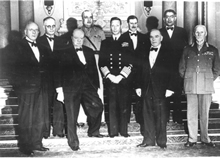 Curtin with Dominion leaders, 1944. Left to Right:- The Rt. Hon. Peter Fraser, The Rt. Hon. John Curtin, The Rt. Hon. W.S. Churchill, H.M. The Maharajah of Kashmir, His Majesty the King, Sir Godfrey Huggins, The Rt. Hon. Mackenzie King, Sir Firoz Khan Noon and Field Marshal The Rt. Hon. J.C. Smuts. Records of Frederick McLaughlin. JCPML00018/16.
Curtin with Dominion leaders, 1944. Left to Right:- The Rt. Hon. Peter Fraser, The Rt. Hon. John Curtin, The Rt. Hon. W.S. Churchill, H.M. The Maharajah of Kashmir, His Majesty the King, Sir Godfrey Huggins, The Rt. Hon. Mackenzie King, Sir Firoz Khan Noon and Field Marshal The Rt. Hon. J.C. Smuts. Records of Frederick McLaughlin. JCPML00018/16.
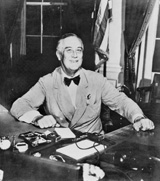 Franklin Delano Roosevelt, the 32nd President of the United States. Roosevelt was re-elected for a fourth 4-year term on 7 November, 1944. Australian War Memorial Negative Number P02451.012.
Franklin Delano Roosevelt, the 32nd President of the United States. Roosevelt was re-elected for a fourth 4-year term on 7 November, 1944. Australian War Memorial Negative Number P02451.012.
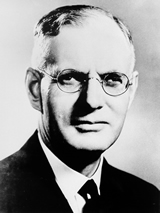 Rt Hon John Curtin (1885-1945) Prime Minister 1941-1945. JCPML00036/13.
Rt Hon John Curtin (1885-1945) Prime Minister 1941-1945. JCPML00036/13.
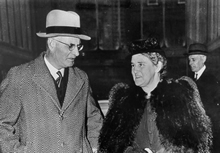 John and Elsie Curtin in Washington, USA 23 April 1944. Records of the Curtin Family. JCPML00376/66.
John and Elsie Curtin in Washington, USA 23 April 1944. Records of the Curtin Family. JCPML00376/66.